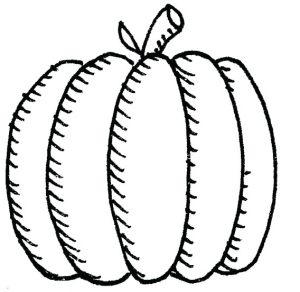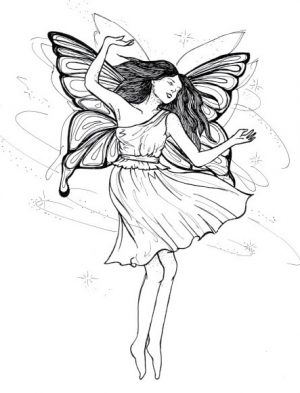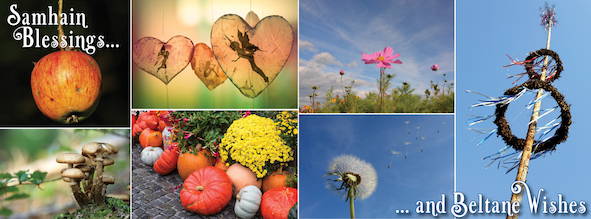 Samhain blessings to everyone in the southern hemisphere, and to those in the north, magical Beltane wishes…
Samhain blessings to everyone in the southern hemisphere, and to those in the north, magical Beltane wishes…
Samhain, the festival of the ancestors and the dead that marks the beginning of winter, falls in early May in the southern hemisphere (in 2018, it falls on May 5) and early November in the northern hemisphere – and on October 31 in popular culture, where it is celebrated as Halloween. It honours the Wheel of the Year as it turns towards the barrenness of winter, in nature and in our lives, and is a time of withdrawal and withering.
Mythologically, this was when the goddess became the crone, the old one, the wise one – the earth mother who understood, and taught others, that we need darkness and death to have light and rebirth. In some traditions the god descended to the underworld on this day, to await his transformation at the winter solstice; in others he was already there and the goddess returned to be reunited with her consort.
Astronomically, this cross-quarter day falls midway between the autumn equinox and the winter solstice. In the southern hemisphere, it’s when the sun is halfway between the Equator and the Tropic of Cancer, on its way north for winter, and it rises in the same position as it will at Imbolc. In the northern hemisphere Samhain occurs six months later, when the sun is heading south from the Equator down to the Tropic of Capricorn.
Samhain, also known as Halloween, All Souls Eve, Day of the Dead, Feast of Spirits, Shadow Fest and Ancestor Night, marks the end of autumn and the start of the coldness and dark of winter. The crispness and vivid flame-coloured beauty of autumn fades as the energy of the earth withdraws and nature starts to wither and die. Animals begin to migrate or hibernate, and while the grass may become green and lush with the onset of rain, many of the trees are stripped bare, with bitterly cold winds adding to the starkness of the season.
This was the third and last harvest of the year, when anything left in the fields, from wheat and oats to turnips and apples, would be gathered in and stored for the barren months ahead. Snow covered the land and fresh food was scarce. Cattle and sheep were brought in from the summer paddocks to the barns, and those who couldn’t find food or shelter were slaughtered and preserved for later eating. Wood was chopped and peat stacked for the winter fires, herbs were dried and food was baked and preserved. Families gathered together to prepare and ready themselves for winter, and there was an air of celebration and abundance even as the hard months approached.
Symbolically the energy is also about preparing for what’s ahead, harvesting and releasing the things you’ve been holding on to and readying yourself for new challenges and experiences. Winter is a season of introspection and darkness, both metaphorically and literally, which encourages you to slow down and withdraw a little to conserve mental energy. It’s a time for inner reflection and contemplation, of studying the Mysteries – of your magical tradition or your life – and scrying for answers and illumination. At each of the four cross-quarter days the veil between the worlds was considered to be thinner than usual, and at this one people connected with the energy of the ancestors, the spirits and the dead, calling on them for wisdom and knowledge about the future as well as the past.
Samhain was the Celtic New Year, the most important, sacred and magical celebration of the pagan calendar. Rituals were performed, elaborate feasts were held, and hearth fires were extinguished in every home so they could be relit from a special druidic fire in each community, which brought blessings and new light to the coming year, and rekindled the hopes and dreams that had been slumbering.
You can find some Samhain recipes here…
 In the northern hemisphere, Beltane, also known as Bealtaine (bright fire), May Day, Walpurgis Night, the Festival of Flowers and Floralia, falls in early May (in 2018, May 5). It marks the first day of summer, and the evidence of new life is everywhere, in abundant blossoms, the hatching of birds, and bees pollinating flowers. The seeds planted in spring have germinated and sprouted, and the land is warm, buzzing and green. Brightly coloured flowers were traditionally brought inside to symbolise fresh beginnings and the power of nature, and pretty white blossoms were gathered from the sacred hawthorn tree, which was associated with Beltane and used for love spells, in marriage rituals, to make wands as well as for protection and healing. Women would also bathe their faces in the dew gathered from their garden on Beltane morning to harness the energy of youth.
In the northern hemisphere, Beltane, also known as Bealtaine (bright fire), May Day, Walpurgis Night, the Festival of Flowers and Floralia, falls in early May (in 2018, May 5). It marks the first day of summer, and the evidence of new life is everywhere, in abundant blossoms, the hatching of birds, and bees pollinating flowers. The seeds planted in spring have germinated and sprouted, and the land is warm, buzzing and green. Brightly coloured flowers were traditionally brought inside to symbolise fresh beginnings and the power of nature, and pretty white blossoms were gathered from the sacred hawthorn tree, which was associated with Beltane and used for love spells, in marriage rituals, to make wands as well as for protection and healing. Women would also bathe their faces in the dew gathered from their garden on Beltane morning to harness the energy of youth.
For much more on Beltane, click here.
You can find some Beltane recipes here…



Get Social